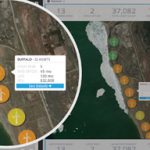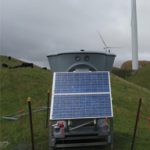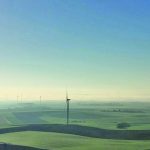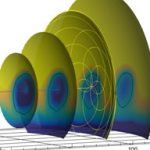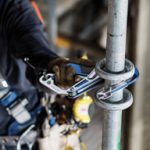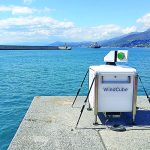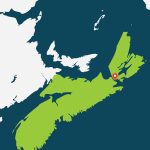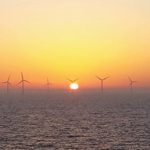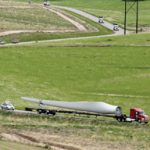At present, the efficiency of a wind turbine cannot be accurately measured because of inadequate data on the wind field across the swept area of the rotors. This poor correlation between energy generation and wind conditions conceals the true state of turbines and affects the accuracy of the 24 hours forecast of power output.
Inadequate Performance Evaluation
Turbine performance is usually evaluated using power curves that express electricity generation as a function of wind speed.
The power curve is based on data from the nacelle-mounted anemometer and on the 15-second average power output. However, using the 15-second averaged figure means that the change in actual output cannot be clearly assigned to the measured wind speed (Figure 1). This ambiguity (output in relation to wind speed) can mainly be attributed to the inaccurate and incomplete nature of wind measurements being taken by the anemometer (which fails to take account of shear winds, wind direction, and changes in wind direction). This makes it impossible to determine the actual efficiency of the turbine. This disparity means that, even now, production losses of up to 10 percent cannot be identified with any degree of certainty. The reasons for the loss in efficiency therefore remain undetected, which in turn reduces the competitiveness of the turbine owner/operator.
Indeterminate Energy Yield
Energy yield presents another problem. There are many different reasons why losses occur when wind is converted into energy—one of these being a lack of precision when determining the actual wind direction.
Wind direction is established using a wind vane mounted on the nacelle. But the wind vane—like the anemometer—has a number of shortcomings. On aspect is that first, it is located behind the rotor blades in a turbulent airstream and therefore has to take measurements over a long period of time if it is to supply meaningful data. Moreover, it only measures at one point in the flow field of the swept area, and consequently cannot record all the important data. The wind vane is also affected by the flow conditions prevailing at the nacelle itself and this in turn creates additional measurement errors (Figure 2).
Inadequate Turbine-Output Forecasts
The use of 24-hour wind power forecasting is becoming increasingly popular as more and more wind power is traded on electricity markets.
The forecast consists of a weather report for the turbine site and a calculation of the power output under the forecasted conditions. The forecast for the following day is based on numerical simulations projected on to a grid, which nodal points are some three to eight kilometers apart. Seventy percent of all forecasting errors are connected with this process and relate to the difficulties that arise when trying to accurately predict weather front movements.
The remaining 30 percent of errors are caused by “downscaling,” the process whereby the predicted wind direction at the nodal points is assigned to the actual site of the turbine. To illustrate this, we have taken an NREL forecast (NREL/CP-550-48146) (Figure 3) that compares the yield from a wind farm with the actual air flow measured by a weather station set up in the park.
As the figure shows, the relationship between energy and wind speed at the weather station presents a very fuzzy and ambiguous picture. In fact, when the wind speed is 10 m/s the power output varies between 100 MW and 300 MW. With more precise mapping (creating a link or correlation between the wind-field data at the respective nodal points and the corresponding wind turbine), not only in terms of wind speed but also for shear, turbulence, and changes in wind direction, the error rate associated with downscaling could be reduced.
Full-Field Wind Measurements Based on Blade Deflection
The aforementioned problems could be tackled by taking full-field measurements with a wind sensor. The underlying technology combines measurements of blade deformation with a highly advanced signal analysis and processing unit. Blade deformation is recorded by a digital camera, which tracks the displacement of reflectors embedded deep inside the rotor blades. As the “raw camera signals” are not very meaningful on their own, they are then relayed to a computer in the nacelle for real-time analysis and processing.
A one-year field trial compared flow speed, wind direction, shear wind components, changes in wind direction, and turbulence levels with the values recorded by a continuous-wave LIDAR system installed on the rotor hub. The LIDAR is equipped with a rotating prism that can pivot the laser beam so as to provide a comprehensive description of the prevailing wind field. The field trial found an excellent match between the blade-based wind sensor and the LIDAR. This consistency was based on 15-second mean data, whereby errors and discrepancies could be identified much more easily than with the 10-minute data. Moreover, during the test the wind vane was rotated manually through a precisely measured angle, whereupon the wind sensor was able to detect this deviation within 30 minutes to an accuracy of 0.3 degrees.
More Precise Power Curves
The blade-sensor’s ability to provide a complete and instantaneous measurement of the wind field means that much more precise power curves can be obtained. By gaining immediate access to information about the complete wind-field conditions, it becomes possible to calculate the wind speed but also wind shear, turbulence levels, and wind shift at the moment of power generation. The measured power output can thus be broken down into “bins” (categories) according to wind shear, turbulence, and wind shift, which allows power curves to be generated for each categorized wind-field condition (Figure 4).
Determining Actual Efficiency
Having an accurate and clearly defined power curve, along with information about all prevailing wind-field conditions (bins), allows us to determine the actual efficiency of the turbine. Let us assume that the output of the turbine is below its specified rating. Is this because the installation itself is less efficient than it should be? To answer this question we need to look at the wind-field category (bin) that corresponds to the manufacturer’s power curve. If there is no divergence between the two then the turbine is operating at full efficiency. In such a case the reason has to be sought in the wind field, or more precisely in the bin in which the turbine is being operated most of the time. If there is a divergence here, the data from the wind sensor can be used to carry out a targeted root cause analysis.
More Accurate Mapping Through “Experience”
As stated above, errors in downscaling can be greatly reduced if accurate information is available on the prevailing wind field. The data can be used to achieve much more precise mapping between the values at the computational grid points and each individual turbine. This mapping would then build on the bin values used in the power curve and in practice continuously improve through “experience” (learning from errors between predicted and actual output).
Conclusions and Outlook
Being able to make better assessments of turbine output is a top priority for turbine owners and operators. Wind speed, wind direction, wind shear, changes in wind direction, and turbulence in the wind field can now be measured with real accuracy and this makes for more exact power curves, increased energy production, better 24-hour forecasts, and more accurate blade condition monitoring. This new technology is both cost-effective and extremely reliable. Moreover, it can be used on every turbine and consequently offers significant potential for improving the competitiveness of the wind power industry.
| +49 5976 946 0 | www.emersonindustrial.com | EmersonIndustrialAutomation |




















